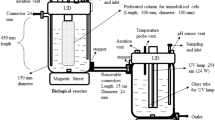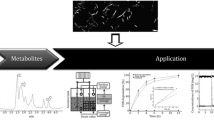Abstract
Degradation of phenanthrene byPseudomonas aeruginosa AK1 was examined in (i) an aqueous mineral salts medium to which phenanthrene particles of varying size (i.e. diameter) were added, and (ii) an aqueous/organic biphasic culture system consisting of mineral salts medium supplemented with 2,2,4,4,6,8,8-heptamethylnonane (HMN) as the phenanthrene-carrying organic phase. In both systems, the rate of phenanthrene biodegradation could be significantly enhanced by manipulations leading to improved phenanthrene mass transfer into the aqueous phase. With crystalline phenanthrene, the rate of biodegradation was found to be directly correlated to the particle surface area, whereas in the biphasic system the rate of biodegradation of the dissolved phenanthrene was mainly governed by the HMN/water interface area. In the latter system, exponential growth with a doubling time t d of 6–8 hours has been achieved under conditions of intensive agitation of the medium indicating that phenanthrene degradation by strain AK1 is limited mainly by physicochemical parameters. Addition of selected surfactants to the culture medium was found to accelerate phenanthrene degradation by strain AK1 only under conditions of low agitation (in the presence of HMN) and after pretreatment of phenanthrene crystals by ultrasonication (in the absence of HMN). Evidence is presented that the stimulating effect of the surfactants was primarily due to improved dispersion of phenanthrene particle agglomerates (in the aqueous mineral salts medium supplemented with phenanthrene crystals) or of the phenanthrene-carrying lipophilic solvent drops (in the aqueous/organic biphasic culture system) whereas the solubilizing activity towards phenanthrene was neglectible. Under conditions of intensive mixing of the culture medium (i.e. if a high particle surface area or HMN/water interface area, respectively, is provided), the addition of surfactants did not enhance phenanthrene biodegradation.
Similar content being viewed by others
References
Alexander M (1973) Nonbiodegradable and other recalcitrant molecules. Biotechnol Bioeng 15: 611–647
—— (1975) Environmental and microbiological problems arising from recalcitrant molecules. Microbial Ecol 2: 17–27
Andelman JB & Snodgrass JE (1974) Incidence and significance of polynuclear aromatic hydrocarbons in the water environment. CRC Crit Rev Environ Control 5: 69–83
Blumer M (1976) Polycyclic aromatic compounds in nature. Sci American 234: 34–44
Boethling RS (1984) Biodegradation testing of insoluble chemicals. Environ Toxicol Chem 3: 5–7
Cameotra SS, Singh HD, Hazarika AK & Baruah JN (1983) Mode of uptake of insoluble solid substrates by microorganisms II: Uptake of solid n-alkanes by yeast and bacterial species. Biotechnol Bioeng 25: 2945–2956
Cerniglia CE (1984) Microbial metabolism of polycyclic aromatic hydrocarbons. Adv Appl Microbiol 30: 31–71
Chakravarty M, Singh HD & Baruah JN (1975) A kinetic model for microbial growth on liquid hydrocarbons. Biotechnol Bioeng 17: 399–412
Dzombak DA & Luthy RG (1984) Estimating adsorption of pylycyclic aromatic hydrocarbons on soils. Soil Sci 137: 292–307
Efroymson RA & Alexander M (1991) Biodegradation by anArthrobacter species of hydrocarbons partitioned into an organic solvent. Appl Environ Microbiol 57: 1441–1447
Foght JM, Gutnick DL & Westlake WS (1989) Effect of emulsan on biodegradation of crude oil by pure and mixed cultures. Appl Environ Microbiol 55: 36–42
Goswami PC, Singh HD, Bhagat SD & Baruah JN (1983) Mode of uptake of insoluble solid substrates by microorganisms I: Sterol uptake by anArthrobacter species. Biotechnol Bioeng 25: 2929–2943
Heitkamp MA, Freeman JP, Miller DW & Cerniglia CE (1988) Pyrene degradation by aMycobacterium sp.: Identification of ring oxidation and ring fission products. Appl Environ Microbiol 54: 2556–2565
Hommel RK (1990) Formation and physiological role of biosurfactants produced by hydrocarbon-utilizing microorganisms. Biodegradation 1: 107–119
Huang S-Y & Chou MS (1989) Kinetic model for microbial uptake of insoluble solid-state substrate. Biotechnol Bioeng 35: 547–558
Kelley I, Freeman JP, Evans FE & Cerniglia CE (1991) Identification of a carboxylic acid metabolite from the catabolism of fluoranthene by aMycybacterium sp. Appl Environ Microbiol 57: 636–641
Mahaffey WR, Gibson DT & Cerniglia CE (1988) Bacterial oxidation of chemical carcinogens: formation of polycyclic aromatic acids from benz(a)anthracene. Appl Environ Microbiol 54: 2415–2423
Oberbremer A, Müller-Hurtig R & Wagner F (1990) Effect of the addition of microbial surfactants on hydrocarbon degradation in a soil population in a stirred reactor. Appl Microbiol Biotechnol 32: 485–489
Rosenberg E (1986) Microbial surfactants. CRC Crit Rev Biotechnol 3: 109–132
Sims RC & Overcash MR (1983) Fate of polynuclear aromatic compounds (PNAs) in soil-plant systems. Residue Rev 88: 1–68
Stucki G & Alexander M (1987) Role of dissolution rate and solubility in biodegradation of aromatic compounds. Appl Environ Microbiol 53: 292–297
Thomas JM, Yordy JR, Amador JA & Alexander M (1986) Rates of dissolution and biodegradation of water-insoluble organic compounds. Appl Environ Microbiol 52: 290–296
Volkering F, Breure AM, Sterkenburg A & van Andel JG (1992) Microbial degradation of polycyclic aromatic hydrocarbons: Effect of substrate availability on bacterial growth kinetics. Appl Microbiol Biotechnol 36: 548–552
Walter U, Beyer M, Klein J & Rehm HJ (1991) Degradation of pyrene byRhodococcus sp. UW1. Appl Microbiol Biotechnol 34: 671–676
Weissenfels WD, Klewer H-J & Langhoff J (1992) Adsorption of polycyclic aromatic hydrocarbons (PAHs) by soil particles: Influence on biodegradability and biotoxicity. Appl Microbiol Biotechnol 36: 689–696
Weissenfels WD, Beyer M, Klein J & Rehm HJ (1991) Microbial metabolism of fluoranthene: Isolation and identification of ring fission products. Appl Microbiol Biotechnol 34: 528–535
Wilke CR & Chang P (1955) Correlation of diffusion coefficients in dilute solutions. AIChE J 1: 264–270
Wodzinski RS & Bertolini D (1972) Physical state in which naphthzalene and bibenzyl are utilized by bacteria. Appl Microbiol 23: 1077–1081
Wodzinski RS & Larocca D (1977) Bacterial growth kinetics on diphenylmethane and naphthalene-heptamethylnonane mixtures. Appl Environ Microbiol 33: 660–665
Wodzinski RS & Coyle JE (1974) Physical state of phenanthrene for utilization by bacteria. Appl Environ Microbiol 27: 1081–1084
Zilber IK, Rosenberg E & Gutnick D (1980) Incorporation of32P and growth of pseudomonad UP-2 onn-tetracosane. Appl Environ Microbiol 40: 1086–1093
Author information
Authors and Affiliations
Rights and permissions
About this article
Cite this article
Köhler, A., Schüttoff, M., Bryniok, D. et al. Enhanced biodegradation of phenanthrene in a biphasic culture system. Biodegradation 5, 93–103 (1994). https://doi.org/10.1007/BF00700634
Accepted:
Issue Date:
DOI: https://doi.org/10.1007/BF00700634




